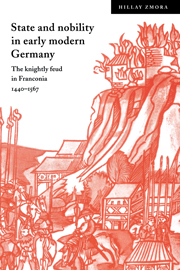Book contents
- Frontmatter
- Contents
- List of figures
- List of tables
- Preface
- List of abbreviations
- 1 The problem of the feud
- 2 The politics of violence: feuding in late medieval Franconia
- 3 The Franconian nobility
- 4 Prosopography of feuding noblemen
- 5 State, nobility, and lordship: the feud interpreted
- 6 The decline of the feud
- A note on Appendixes
- Appendix A Creditors and guarantors of the margraves of Brandenburg
- Appendix B Sample of intermarriages among the noble élite
- Appendix C Individual parameters of feuders (Sample-I)
- Appendix D Family parameters of feuders (Sample-I)
- Appendix E Individual parameters of feuders (Sample-II)
- Appendix F Family parameters of feuders (Sample-II)
- Sources of information for Appendix A
- Sources of Information for Appendixes C and D
- Sources of Information for Appendixes E and F
- Selected bibliography
- Index
- CAMBRIDGE STUDIES IN EARLY MODERN HISTORY
4 - Prosopography of feuding noblemen
Published online by Cambridge University Press: 29 October 2009
- Frontmatter
- Contents
- List of figures
- List of tables
- Preface
- List of abbreviations
- 1 The problem of the feud
- 2 The politics of violence: feuding in late medieval Franconia
- 3 The Franconian nobility
- 4 Prosopography of feuding noblemen
- 5 State, nobility, and lordship: the feud interpreted
- 6 The decline of the feud
- A note on Appendixes
- Appendix A Creditors and guarantors of the margraves of Brandenburg
- Appendix B Sample of intermarriages among the noble élite
- Appendix C Individual parameters of feuders (Sample-I)
- Appendix D Family parameters of feuders (Sample-I)
- Appendix E Individual parameters of feuders (Sample-II)
- Appendix F Family parameters of feuders (Sample-II)
- Sources of information for Appendix A
- Sources of Information for Appendixes C and D
- Sources of Information for Appendixes E and F
- Selected bibliography
- Index
- CAMBRIDGE STUDIES IN EARLY MODERN HISTORY
Summary
The group of feuding noblemen under discussion is a fictitious one. It is made up for, and depends upon, research procedures. Necessarily, an analysis of it has another goal than prosopography in the classic, Symian sense of uncovering the dark reality behind the façade of political rhetoric. The aim of this prosopographical study is merely to identify the social lineaments of the feuders. This will serve to create a frame of reference for an interpretation of the feud.
METHOD
The composition of the group of feuding noblemen hinges ultimately on the definition of a ‘feuder’. Unlike ‘feud’, the term ‘feuder’ does not involve conceptual difficulties, and it is safe to follow contemporary nomenclature. Whether war or feud, late medieval Germans usually distinguished between the principal foes or feuders on the one hand and their helpers on the other. This distinction was a fundamental juristic tenet of the feud. The principals represented and were responsible for their workforce. The duration and conclusion of a feud rested solely with them.
This discrimination between principals and helpers underlies the constitution of the sample of feuding noblemen. It is the primary principle of selection, and the only one against which there can be no appeal, if the sample is to have the basic coherence essential for its interpretation. This is so because the helpers' motives often had little affinity with those of the principals. Some joined for booty, others because they were bound by service, still others ‘out of kinship and tradition’. Whether siblings, underlings or hirelings, the helpers' reasons for supporting the principal feuder were ancillary to his.
- Type
- Chapter
- Information
- State and Nobility in Early Modern GermanyThe Knightly Feud in Franconia, 1440–1567, pp. 68 - 86Publisher: Cambridge University PressPrint publication year: 1998

